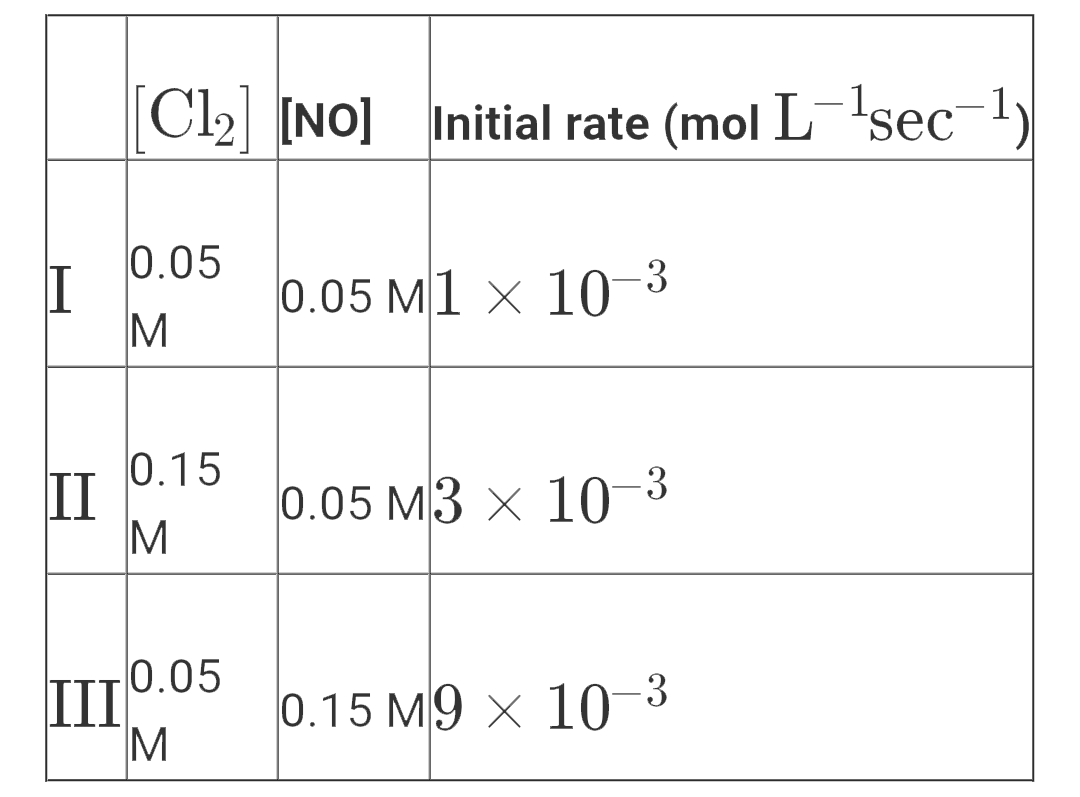Show by uisng rate laws how much the rate of reaction will change if the volume of the reaction vessel is diminished to of its initial volume.
To solve the problem of how the rate of the reaction 2NO(g)+O2(g)→2NO(g) changes when the volume of the reaction vessel is reduced to 13 of its initial volume, we will use the concept of rate laws and concentration.
1. Understanding Concentration:
- Concentration (C) is defined as the number of moles (n) of a substance divided by the volume (V) of the solution:
C=nV
2. Initial Concentration:
- Let the initial volume of the reaction vessel be V. The initial concentrations of NO and O2 can be denoted as CNO and CO2 respectively.
- Therefore, we have:
CNO=nNOV,CO2=nO2V
3. New Concentration After Volume Change:
- When the volume is reduced to 13V, the new concentrations (C′NO and C′O2) will be:
C′NO=nNO13V=3⋅nNOV=3CNO
C′O2=nO213V=3⋅nO2V=3CO2
4. Writing the Rate Law:
- The rate of the reaction can be expressed using the rate law:
Rate=k(NO)2(O2)
- For the initial rate (r1):
r1=k(NO)2(O2)
5. Calculating the New Rate:
- For the new rate (r2) after the volume change:
r2=k(3CNO)2(3CO2)=k⋅9C2NO⋅3CO2=27k(NO)2(O2)
6. Relating the Two Rates:
- Thus, we can relate the new rate to the initial rate:
r2=27⋅r1
Conclusion:
The rate of the reaction increases by a factor of 27 when the volume of the reaction vessel is reduced to 13 of its initial volume.
- Concentration (C) is defined as the number of moles (n) of a substance divided by the volume (V) of the solution:
C=nV
- Let the initial volume of the reaction vessel be V. The initial concentrations of NO and O2 can be denoted as CNO and CO2 respectively.
- Therefore, we have:
CNO=nNOV,CO2=nO2V
- When the volume is reduced to 13V, the new concentrations (C′NO and C′O2) will be:
C′NO=nNO13V=3⋅nNOV=3CNO
C′O2=nO213V=3⋅nO2V=3CO2
- The rate of the reaction can be expressed using the rate law:
Rate=k(NO)2(O2)
- For the initial rate (r1):
r1=k(NO)2(O2)
- For the new rate (r2) after the volume change:
r2=k(3CNO)2(3CO2)=k⋅9C2NO⋅3CO2=27k(NO)2(O2)
- Thus, we can relate the new rate to the initial rate:
r2=27⋅r1
The rate of the reaction increases by a factor of 27 when the volume of the reaction vessel is reduced to 13 of its initial volume.
Topper's Solved these Questions
- CHEMICAL KINETICSBOOK - CENGAGE CHEMISTRY ENGLISHCHAPTER - CHEMICAL KINETICSEXERCISE - Solved Example
52 Videos
- CHEMICAL KINETICSBOOK - CENGAGE CHEMISTRY ENGLISHCHAPTER - CHEMICAL KINETICSEXERCISE - Ex 4.1 (Objective)
9 Videos
- CARBOXYLIC ACIDS AND THEIR DERIVATIVESBOOK - CENGAGE CHEMISTRY ENGLISHCHAPTER - CARBOXYLIC ACIDS AND THEIR DERIVATIVESEXERCISE - Exercises Archives (Analytical And Descriptive)
34 Videos
- COORDINATION COMPOUNDSBOOK - CENGAGE CHEMISTRY ENGLISHCHAPTER - COORDINATION COMPOUNDSEXERCISE - Archives Subjective
18 Videos
Similar Questions
How will the rate of reaction
2SO2(g)+O2(g)→2SO3(g) change if the volume of the reaction vessel is halved?
View SolutionThe reaction,2NO(g)+O2(g)⇔2NO2(g), is of first order. If the volume of reaction vessel is reduced to 13, the rate of reaction would be
View SolutionThe given data are for the reaction, 2NO(g)+Cl(g)→2NOCl(g) at 298K

The rate law of the reactions is
View SolutionFor the first order reaction
2N2O5(g)→4NO2(g)+O2(g)
View SolutionFollowing reaction takes place in one step: 2NO+O2+2NO2 How will the rate of above reaction change if the volume of reaction vessel is reduced to 1/3 rd of original volume? Will there be any change in the order of reaction?
View SolutionHow can you determine the law of the following reaction?
2NO(g)+O2(g)→2NO2(g)
View SolutionThe reaction
SO2(g)+1/2O2(g)→SO3(g) should be
View SolutionFor the reaction
N2(g)+O2(g)⇔2NO(g)
If pressure id increased by reducing the volume of the container then :
View SolutionThe differential rate law for the reaction, 4NH3(g)+5O2(g)→4NO(g)+6H2O(g)
View SolutionFor an elementary reaction. A + 2B → C if volume of the vessel is reduced to 13 of its original volume the rate of the reaction will
View Solution
